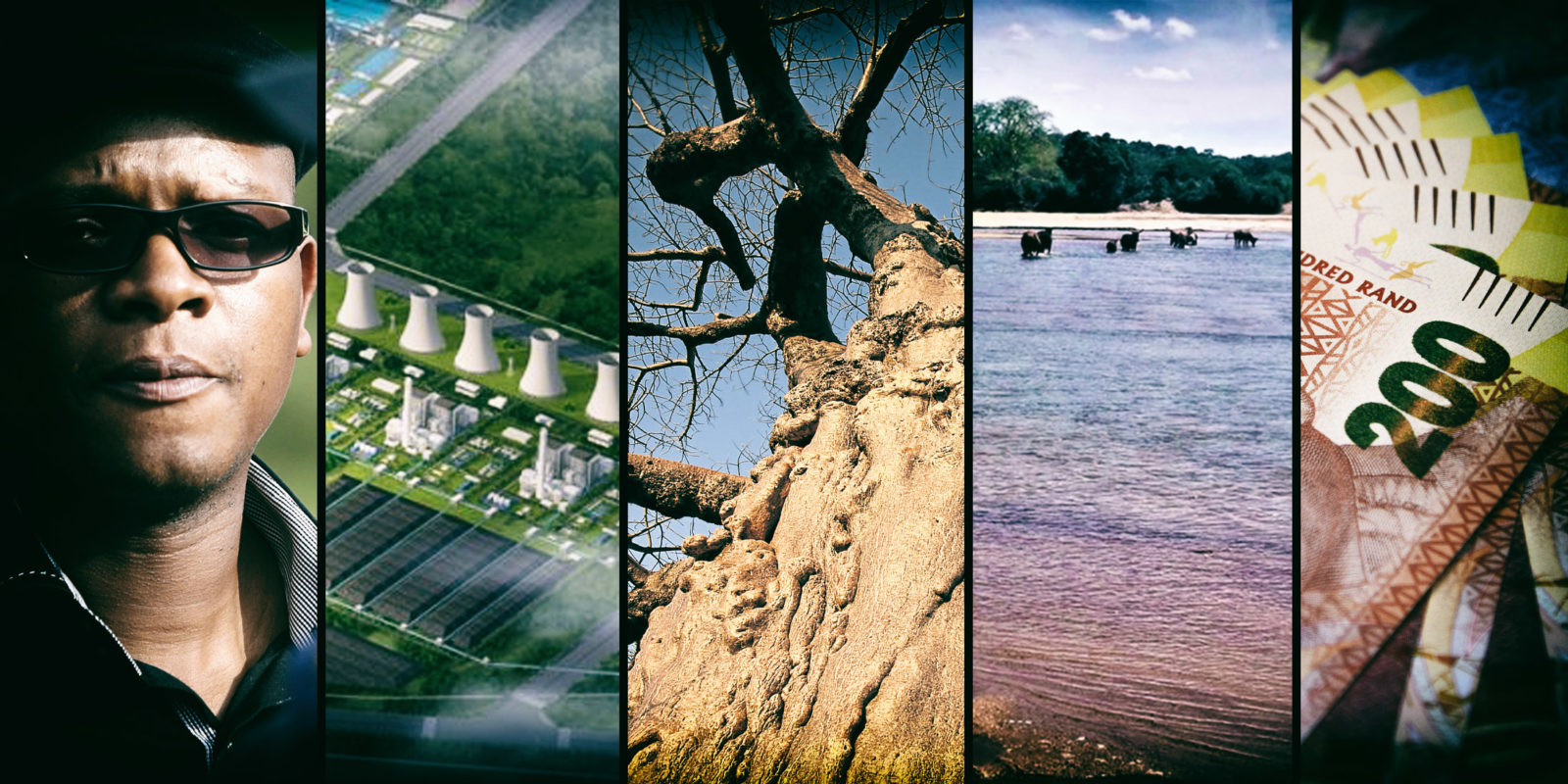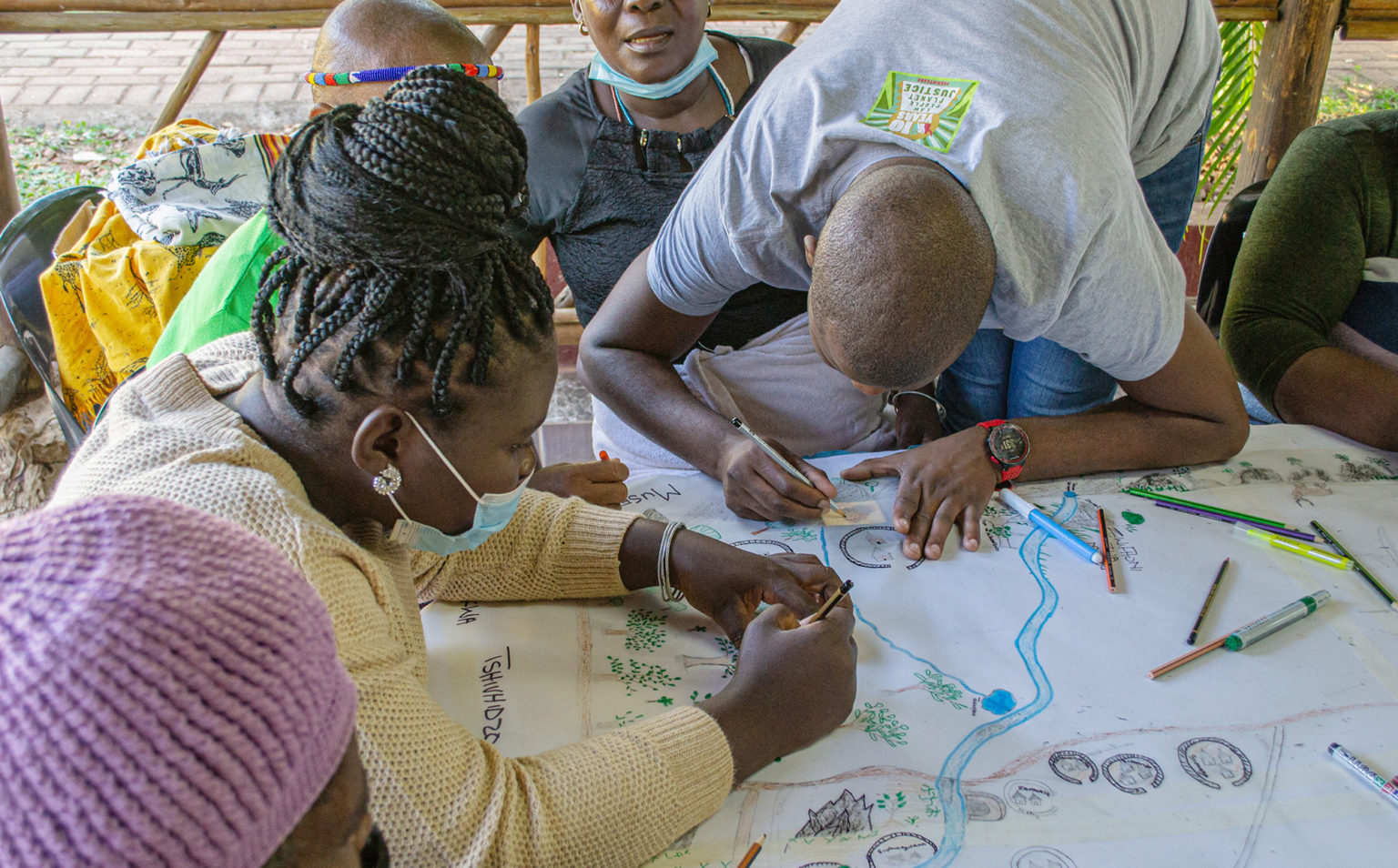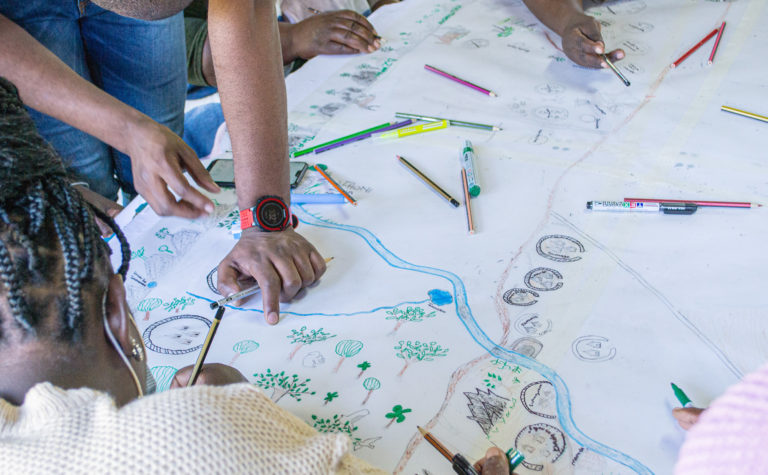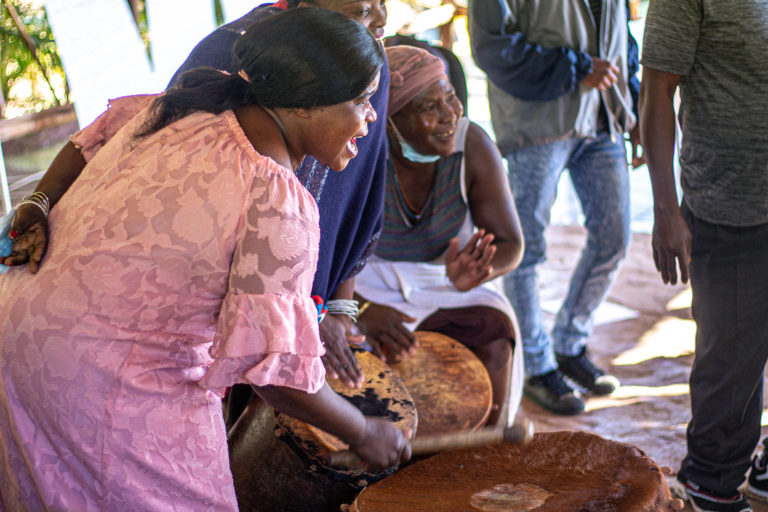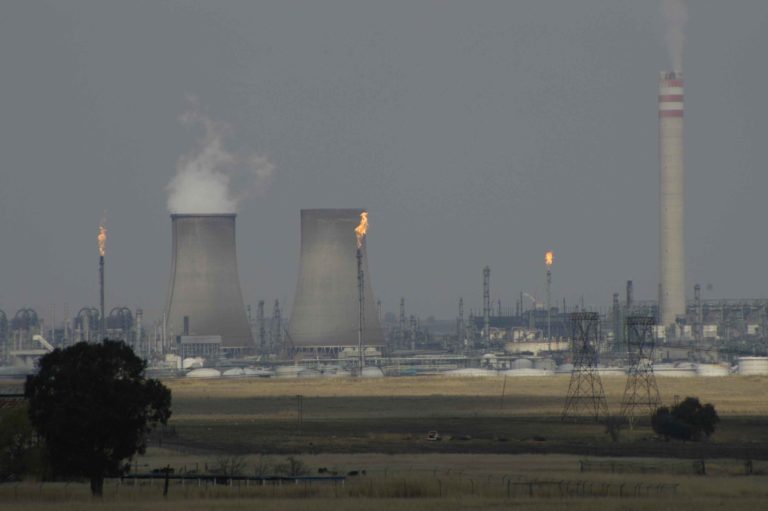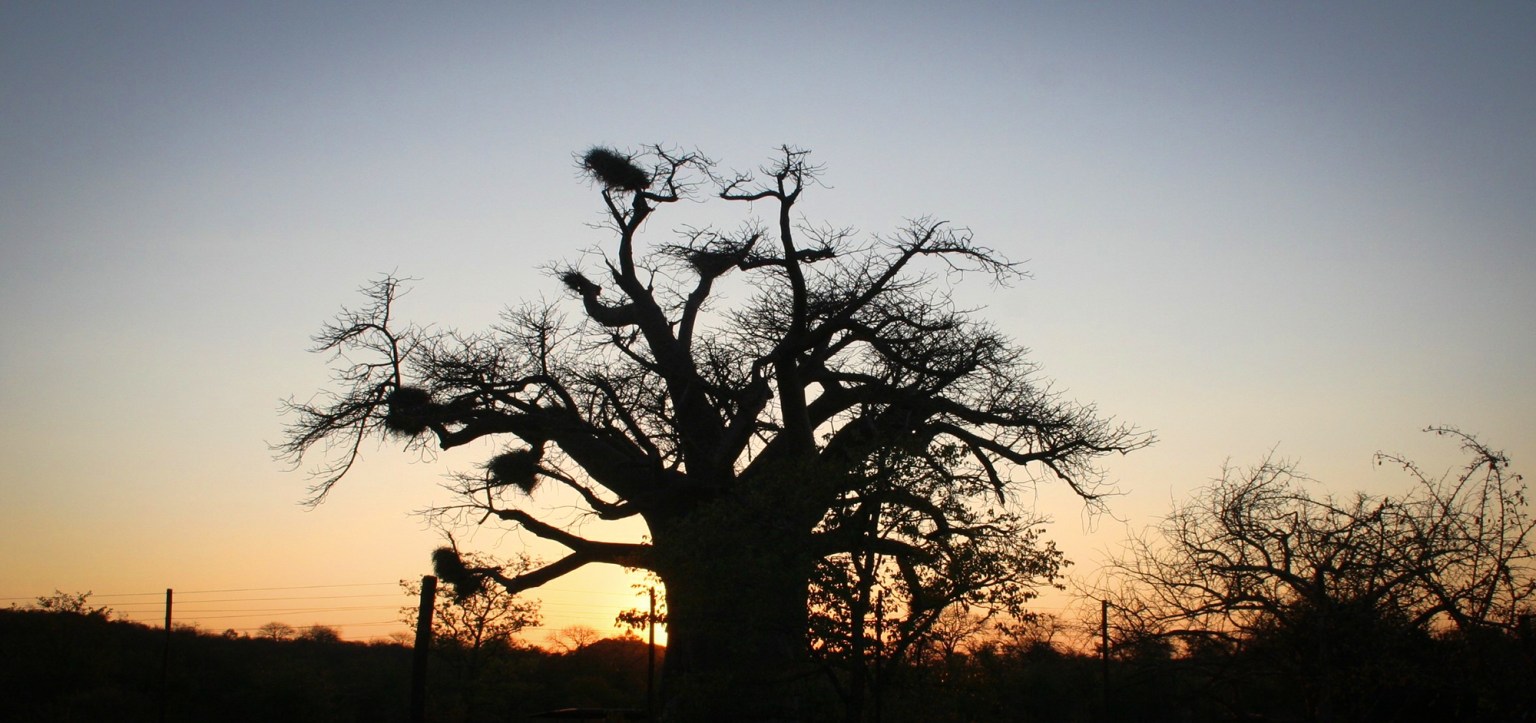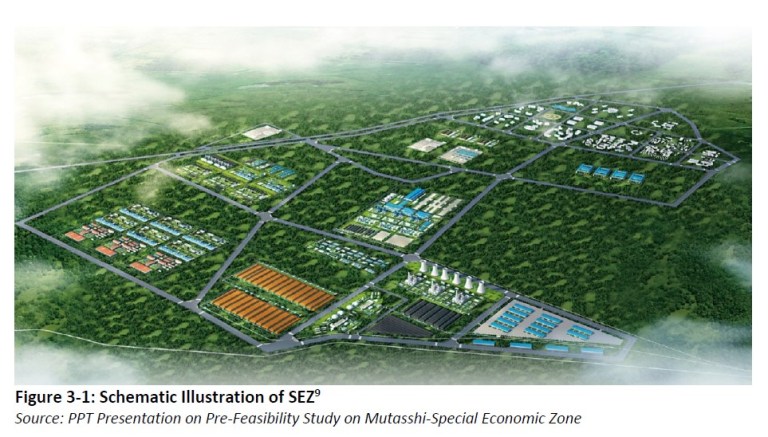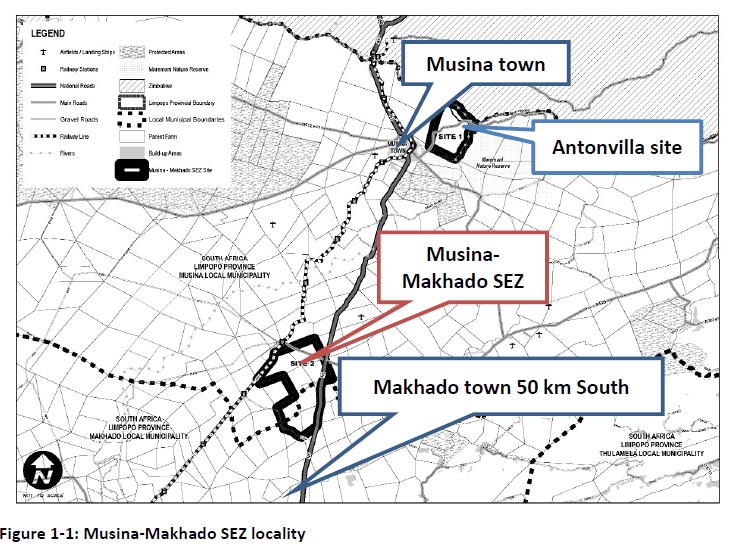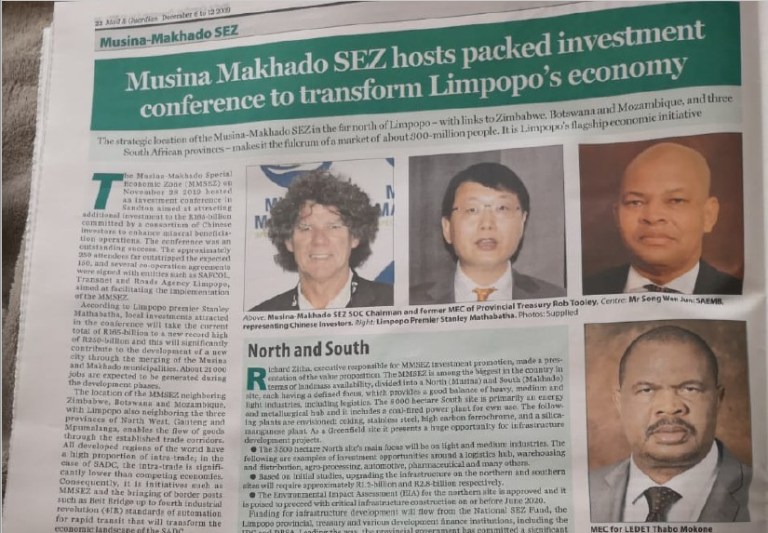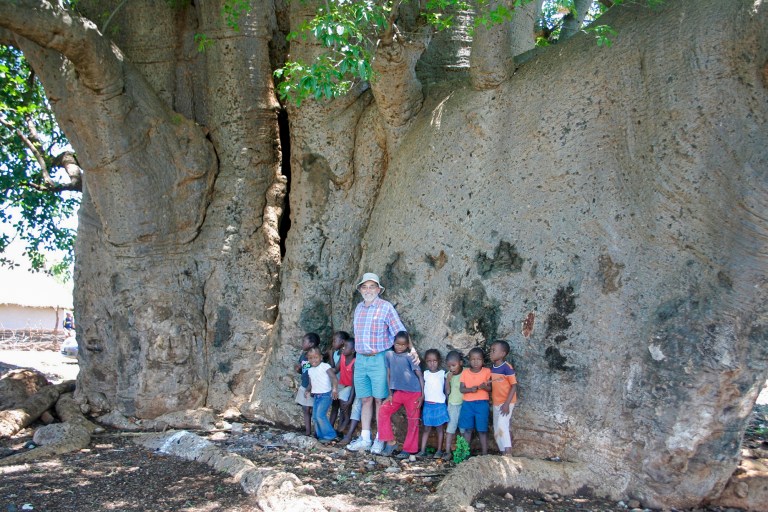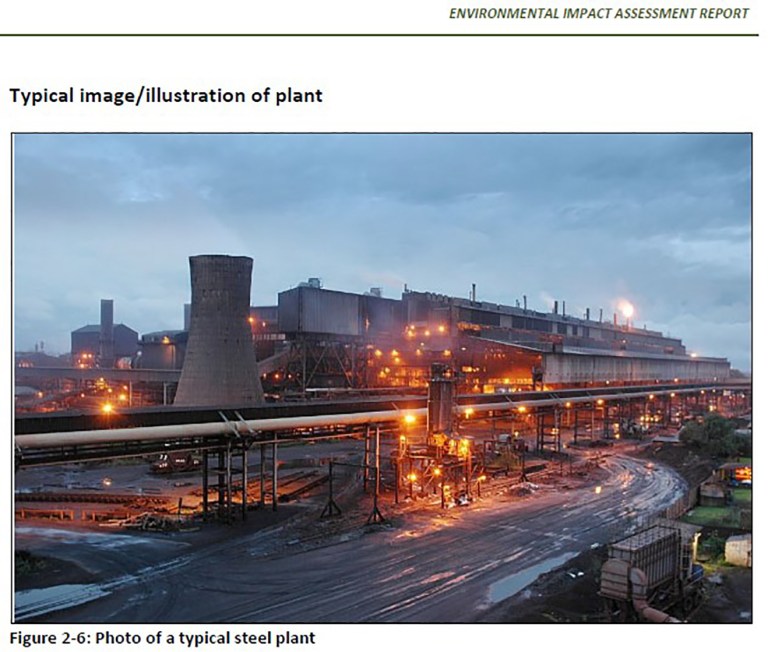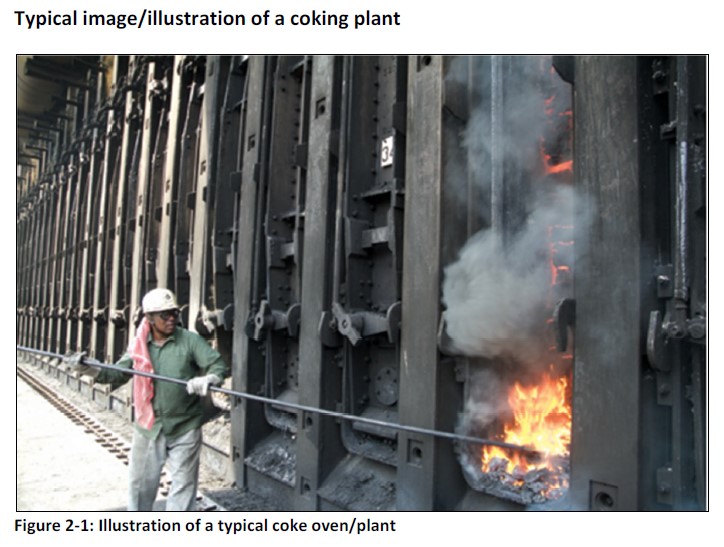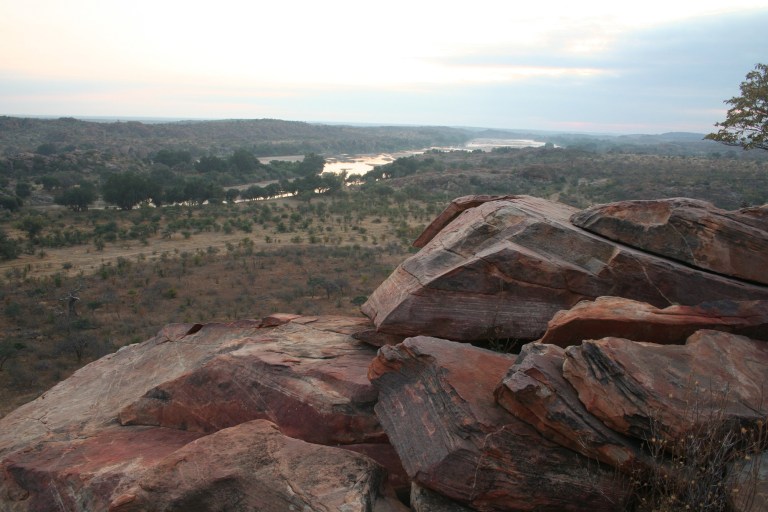How a R10.7bn ‘zero waste’ megaproject was buried by Limpopo’s Chinese deal
By Kevin Bloom• 4 May 2020
In 2017, because of its need to appease the SA government, a local company agreed to ‘conditionally withdraw’ its objections to the Chinese-funded Special Economic Zone in northern Limpopo. But on the day that Daily Maverick’s first article in this series was published, the company learnt that its association with the SEZ had rendered it toxic. Given its insistence that it played by the book on its R10.7bn proposal for an eco-industrial park in the province, the company has now decided to come clean with what it knows.
“As hot as the surface of the sun.”
In September 2011, when Dr Pieter du Toit explained the technology to Cassel Mathale, premier at the time of Limpopo province, he more than likely would have used those words. Like most people, Mathale would have needed something abstract to hang onto — a metaphor that was less concrete, less forbidding, than the pure physics that described the process of plasma waste gasification.
Du Toit may have talked about plasma being the “fourth state of matter,” and that it appeared in its natural form as sunshine, starlight, lightning and the aurora borealis. He may have added that the term was coined by Irving Langmuir, a chemist and physicist, back in 1927. The technology for harnessing plasmas, he almost certainly would have said, had been around for decades, with waste gasification plants up and running in dozens of strategic locations across North America, Europe and the Far East.
Which would have brought Du Toit to the fifth slide in his presentation to the premier on that 2011 spring day. The Limpopo Eco-Industrial Park, or LEIP, had been touted in the slide’s header as the “World’s First Zero Solid Waste Eco-Industrial Park”. This was a bold statement to make, and neither Du Toit (a University of Southern California-trained engineer) nor his partner Deshika Kathawaroo (an environmental scientist trained at the University of the Witwatersrand) were offering any apologies for their ambitions.
By way of elucidation, with the plasma waste gasification plant set up as the LEIP’s core project, Du Toit quoted a definition from experts in the field, an overview that had emerged from a working group of the Zero Waste International Alliance in 2004.
“Zero waste is a goal that is ethical, economical, efficient and visionary,” he would have read to Mathale from the words on the screen, “to guide people in changing their lifestyles and practices to emulate sustainable natural cycles, where all discarded materials are designed to become resources for others to use.
“Zero waste means designing and managing products and processes to systematically avoid and eliminate the volume and toxicity of waste and materials, conserve and recover all resources, and not burn or bury them.”
Of course, Du Toit and Kathawaroo would not have been sitting in Mathale’s office, schooling him on plasmas and the technologies of zero waste, had they not been invited. According to documents in the possession of Daily Maverick, a clear chain of events had led them to Mathale’s door — and the initial event had been a lekgotla for Cabinet ministers and ranking provincial bureaucrats held in January 2011.
Back then, Du Toit and Kathawaroo were working for the Arup Group, a global firm of engineering and design consultants with a relatively large presence in South Africa. When it was Du Toit’s chance to address the lekgotla, he floated the idea of a major industrial complex in the far north of Limpopo province, tactically positioned to take advantage of the transport corridor into Zimbabwe and the continent up north. Apparently, the relevant officials bought the idea immediately, because two months later Du Toit and Kathawaroo were liaising with senior members of the Limpopo Department of Economic Development, Environment and Tourism (LEDET), as advisors to the steering committee tasked with turning the concept into a workable plan.
Du Toit’s background had been in the oil and gas sector, but, as he told Daily Maverick, his partnership with Kathawaroo had soon “converted” him to the technologies of zero solid waste and the design principles of industrial ecology. As for Premier Mathale’s own Damascus moment, which appeared to coincide with the September 2011 presentation, the effects were on full display in the letter he fired off to 10 Cabinet ministers in early 2012.
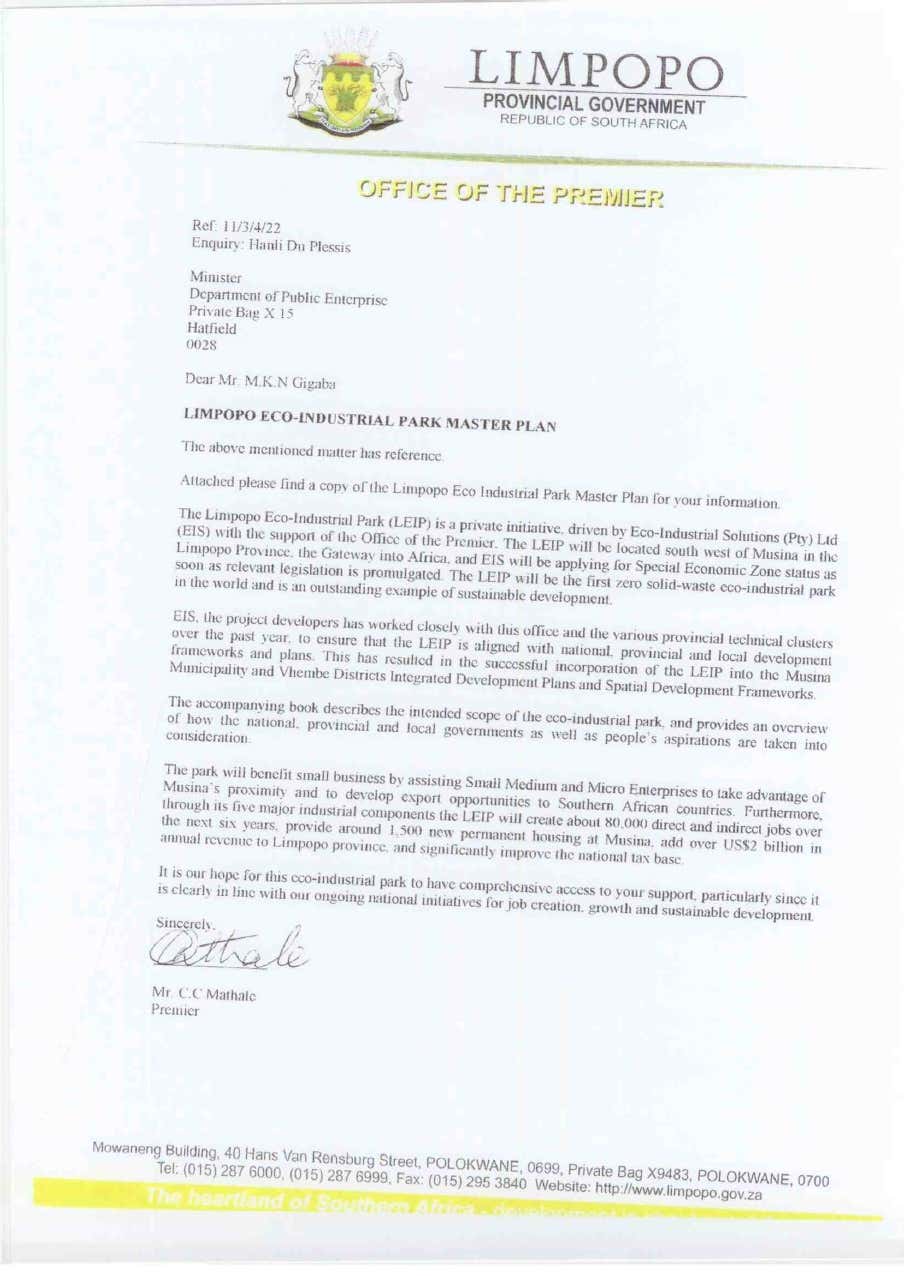
“It is our hope for this eco-industrial park to have comprehensive access to your support,” Mathale concluded the correspondence, “particularly since it is clearly in line with our ongoing national initiatives for job creation, growth and sustainable development.”
And so, on the back of the buy-in from provincial government, the LEIP began to assume some real-world shape. A three-dimensional model – complete with a plasma waste gasification rig, for the transmutation of industrial toxins into synthetic gas-based energy – was placed in the foyer of Mathale’s offices. In the interim, Du Toit and Kathawaroo had left the Arup Group to form their own private company, Eco-Industrial Solutions (EIS), whose core mission was to enable authorities in the public sector to manifest the zero-waste dream.
To do this, while formally integrating the LEIP into the development plans of the Musina Local Municipality, the duo hired consulting ecologists and heritage specialists to scope out the most suitable site. These experts used sensitivity maps to arrive at a final choice from a possible list of 10; a plot of around 7,000 hectares just north of Musina, where the area of highest biological diversity (around 2,200 hectares) would be set aside and protected as an on-site nature reserve.
A fully serviced and secure platform for heavy and light industries was included, as well as incubation facilities for SMMEs. An associated housing project of 4,900 residences, designed to complement the natural environment, was laid out with the attendant schools, hospitals and amenities. The local community would benefit from the LEIP, as per these original plans, via the formation of an industrial ecology faculty aligned to two nearby universities as well as skills development and training centres in all the requisite trades.
So good did things look, in fact, that in September 2013, when the Department of Trade and Industry had just begun to formalise its plans for a Special Economic Zone (SEZ) in the region, the LEIP was identified as one of the “anchor” projects. Alongside the correspondence confirming this status from the DTI’s then-director general Lionel October, Daily Maverick was shown a letter from the Limpopo Economic Development Agency (LEDA), signed and dated 3 March 2014, in which it was all but guaranteed that the LEIP would be incorporated into the nascent SEZ.
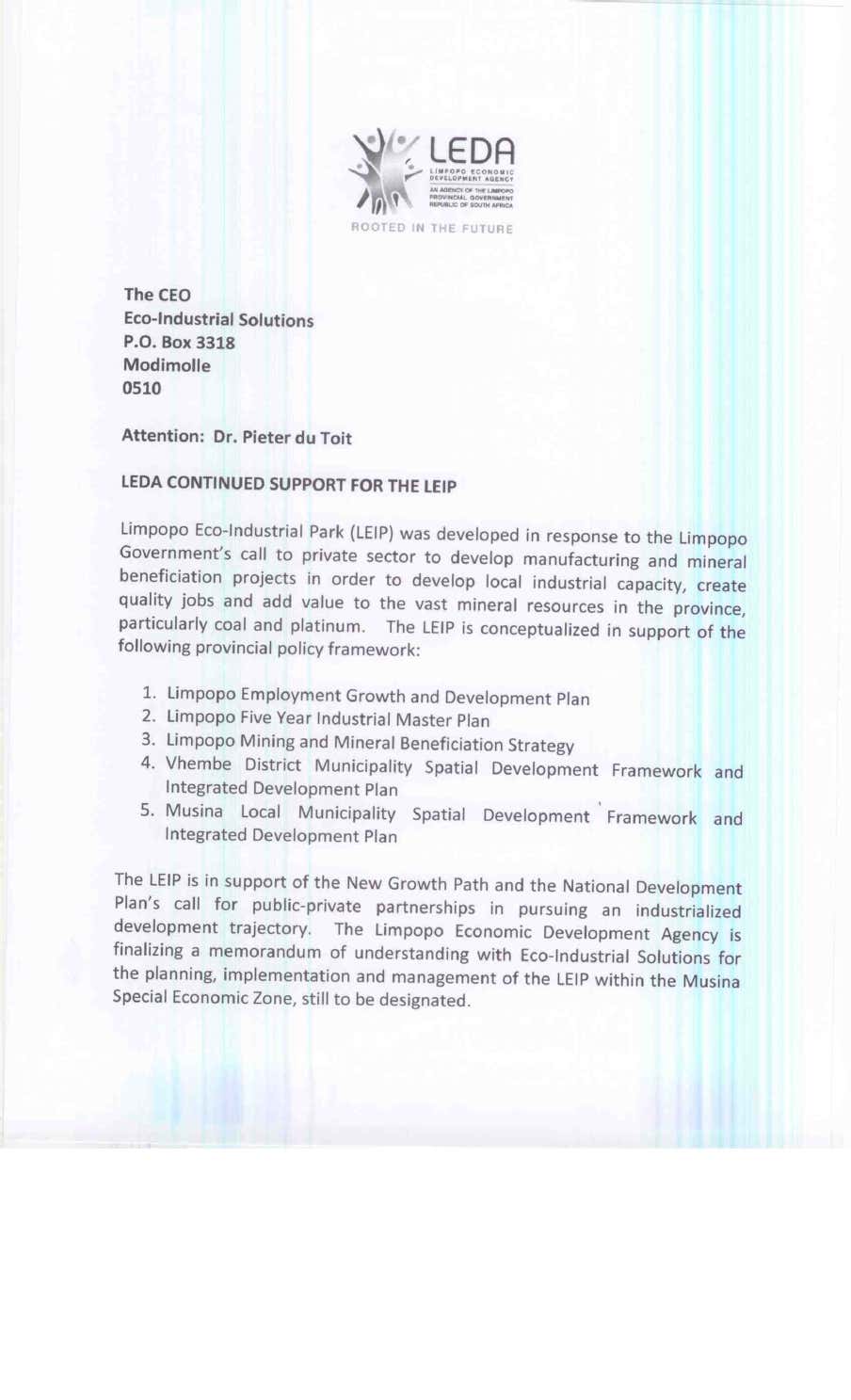
LEDA, according to Amos Shiburi, who was then the agency’s chief programme officer for the SEZ, was in the process of “finalising a Memorandum of Understanding with [EIS]” to this effect.
Shiburi closed off the letter with the following sentence: “LEDA would like to conclude a partnership agreement with [EIS] as soon as possible within the coming two months.”
But that wasn’t to be, allegedly because in October 2014, during a trip to Guangzhou in the People’s Republic of China, Shiburi and other ranking members of LEDA would meet with Ning Yat Hoi, chairman of the Hoi Mor Group, the company destined to become the real (and exclusive) anchor tenant of the Musina-Makhado SEZ.
Cut & Paste
On 4 April 2020, three days after the publication of the first article in this series — entitled “Killing the Holy Ghost: Inside the R145bn plan that would destroy the Limpopo River” — Webster Mfebe, who had recently been appointed chair of the board of both EIS and the LEIP, emailed a seething missive to LEDA. The recipient of his ire was Dr Matata Mokoele, LEDA’s acting CEO.
“As a consequence of LEDA’s conduct and the Daily Maverick article,” Mfebe wrote, “EIS and LEIP are reviewing their relationship with LEDA. More to the point for immediate purposes, since publication of the Daily Maverick article, given Mr Ning’s alleged status as wanted by Interpol for fraud, a number of reputable prospective funders of the LEIP have raised serious reservations in being associated in any way with Mr Ning, Hoi Mor and the [Musina-Makhado SEZ] project.”
Since 2011, it turned out, EIS’s committed costs on the LEIP had amounted to just under R110-million, all of which had been raised from external funders — at R29-million, the largest chunk of this funding had come from the DTI. These total sunk costs, according to information shared with Daily Maverick, had accounted for “the property purchase and technical matters such as surveys, environmental approvals, rezoning and township establishments, engineering designs, conceptual and feasibility studies, and legal corporate and contractual matters”.
In short, EIS did not abandon the LEIP vision after LEDA had reneged on its 2014 promise to conclude a partnership agreement “within two months”. As Mfebe and Kathawaroo would later inform us, they continued on the basis that their vision had never been dependent on the Musina-Makhado SEZ — and, in fact, had preceded it in terms of date of conception by at least two years. By all accounts, however, given the sheer size of both projects and the fact that they were targeted at the same geographic region for what were ostensibly the same “development” objectives, there was simply no way that EIS could have ignored LEDA and the SEZ if they wanted their own project to thrive.
According to Du Toit, during the 18 months following LEDA’s October 2014 trip to China, EIS was subjected to a “frustrating” series of meetings with the agency. Shiburi, he recalled, was not present at any of these meetings, where “impossible paperwork requests” made it increasingly clear to him that LEDA had lost all interest in signing the agreement.
And so in March 2016, when the DTI placed a notice in the Government Gazette to officially designate the Musina-Makhado SEZ, the EIS executives were unsurprised to see that the LEIP had not been included. Not only that, but LEDA had apparently plagiarised 121 pages of EIS’s intellectual property in their own successful application on behalf of Hoi Mor.
Shortly thereafter, on 3 May 2016, the DTI took delivery of an objection to its government notice — a submission of 45 thoroughly researched and footnoted pages, from EIS, that explained why LEDA’s application was in contravention of the Special Economic Zones Act of 2014.
For starters, EIS alleged, LEDA’s feasibility study on the R40-billion Hoi Mor proposal, which was meant to provide a convincing rationale for a metallurgical cluster in an ecologically sensitive zone, was “neither comprehensive nor complete”. Also, foreshadowing a circumstance that Daily Maverick would later confirm regarding the sidelining of ancestral claimants to the land, LEDA had apparently used “vague and confusing” language when identifying the properties to be leased. Finally, there was the charge of outright theft.
“In this regard,” noted the EIS objection, “the pre-feasibility studies and feasibility report made available to the public on the DTI website in connection with the LEDA application comprise approximately 104 and 17 pages, respectively, of information uplifted directly (and in many cases verbatim) from EIS’s proprietary information in respect of the LEIP project.” (Emphasis by the writer)
Given the stakes, the EIS executives weren’t content to leave it there. They demanded — and were duly afforded — a number of opportunities to air their grievances face-to-face. What they ultimately hoped to gain from these meetings, Du Toit and Kathawaroo informed us, was an undertaking from DTI that the guarantees of 2013 would be honoured.
Since the DTI had by then committed almost R30-million in funding to the LEIP, and since the SEZ was essentially a DTI initiative, this did not seem an unreasonable request. But according to documents and meeting minutes that would later be shared with Daily Maverick, the EIS executives were repeatedly asked to resubmit their application for an operating permit to the same Limpopo agency that had allegedly stolen their IP.
“EIS had and continues to have its reservations about submitting the SEZ application to LEDA,” an entry in one of these documents countered, “since it contains highly confidential IP that we fear will be used to support the Chinese development in the Musina-Makhado SEZ.”
Eventually, in May 2017, when it became clear that DTI would not budge on their insistence that LEDA was the rightful authority, Du Toit and Kathawaroo relented. In return for a written agreement, they agreed to “conditionally withdraw” their 45-page objection. On 23 July 2018, four years past the date when it had originally been promised, the MOU between EIS and LEDA was signed.
The preamble stated that the parties agreed to work together “to facilitate the qualification of the LEIP project as one of the anchor projects within the Musina-Makhado SEZ”.
The LEIP would be “developed on its own site,” the agreement continued, and yet would “comply with the SEZ Act” with respect to its “appointment as an operator.”
But again, on 1 April 2020, when Daily Maverick revealed that LEDA and its Chinese partners had almost certainly contravened the SEZ Act and a few more laws besides — not least of which was the National Environmental Management Act of 1998 — the EIS executives felt they had no choice but to go public with their 2016 objections.
“The LEIP has been associated with everything that’s been revealed by Daily Maverick,” Mfebe said in the course of a telephonic interview in mid-April, “and so we have a responsibility to separate the Chinese project from our own local project, which has followed all the laws, environmental and otherwise. We have to satisfy our potential investors that what we have been telling them is the truth.”
As for the identity of these potential investors, while the EIS executives were not at liberty to reveal exactly who had complained, they were more than forthcoming about who they were approaching and the deals that had already been signed.
President’s pet
In late September 2019, a few days after Greta Thunberg had led the largest environmental protest the world had ever seen, the African Development Bank (AfDB) announced at the UN climate summit in New York that it was “getting out” of coal for good. As a cure-all for the energy needs of poor and developing countries, this was perhaps the strongest clue yet that coal’s days were done — not only did the announcement deal a death blow to the “energy poverty” publicity campaigns of the coal conglomerates of the Global North, it signalled the start of a whole new investment trajectory for one of Africa’s foremost funders of infrastructure projects.
Six months later, when EIS was invited to present a funding proposal to the AfDB, it was to this new trajectory that the company’s executives appealed. The introductory slide of their presentation, dated 2 April 2020, referenced the 2015 Paris Agreement and the fact that the interior of South Africa was projected to warm between 5°C and 8°C by the end of the 21st century.
“The LEIP incorporates commercially available technologies that can eliminate pollution and reduce legacy emissions,” the presentation confidently declared.
Still, while the statement was in keeping with the EIS message as originally articulated in 2011, was it fundamentally true? In other words, were Du Toit, Kathawaroo and Mfebe the best people to introduce the technology on such a vast commercial scale?
In order to answer the question, Daily Maverick reached out to Dr Jaco van der Walt, chief scientist of the plasma technology section at the Nuclear Energy Corporation of South Africa (Necsa), the state-owned enterprise with which EIS had concluded a separate MOU in November 2018. The purpose of this particular agreement, from EIS’s point of view, had been to lay the foundations for a more formal and lasting partnership, one in which the parties would collaborate on plasma waste gasification in the LEIP and beyond.
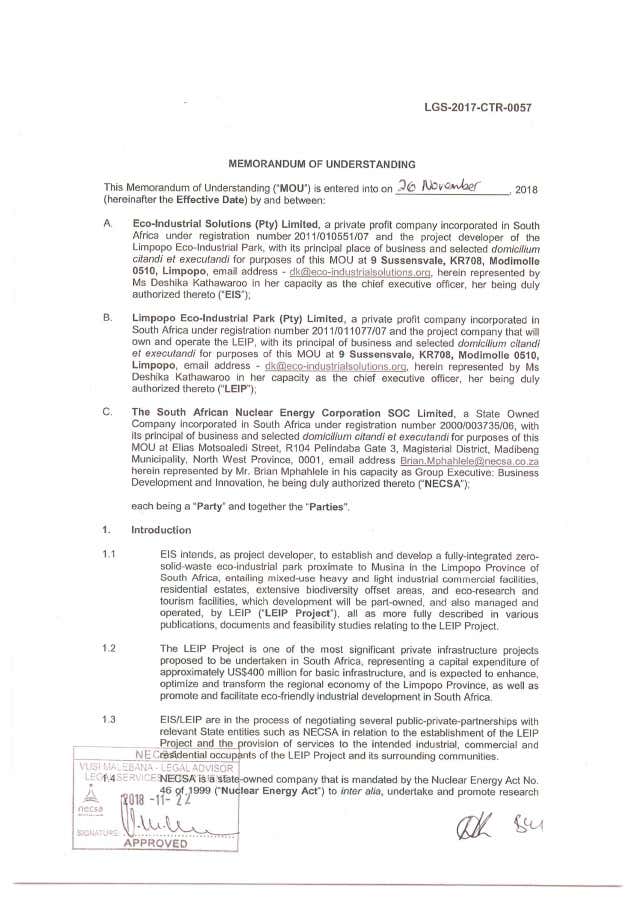
Necsa, explained Van der Walt, had first entered the plasma field under the nuclear fuel cycle programme of the 1980s, when the agency was still known as the Atomic Energy Corporation. In 2010, he added, after this original initiative had been discontinued, a new programme was launched to focus on “the use of thermal plasma technology for waste volume reduction and gasification, and possible conversion of the resultant gas into energy.”
In terms of pure mechanics, then, Van der Walt assured Daily Maverick that EIS’s core proposition was sound. And in terms of the executives’ credibility, while Van der Walt was careful to point out that Necsa did not assign exclusive rights to anyone, he did commit to the following:
“Due diligence evaluation of LEIP and EIS, coupled with their mutually beneficial value proposition, assured Necsa of the need to negotiate a strategic partnership. Necsa would take pride in being associated with the success of the LEIP project which, amongst other objectives, is premised on zero solid waste generation, as well as the development and upliftment of the Limpopo, Musina community.”
By contrast, as the first investigation in this series revealed, the backers of the Musina-Makhado SEZ appeared uninterested in the upliftment of much aside from their own returns on investment. The local rights holders to the SEZ land, although there had been promises of empowerment stakes and preferential shareholdings, had by their own account ended up with nothing more from the R145-billion project than their collective takings off the lease — an income, when divided, that amounted to R350 per month for each community member.
LEDA, as a 51% shareholder in the SEZ and the government agency that had been mandated to negotiate with the local community, did not at any point provide Daily Maverick with evidence to the contrary. Richard Zitha, LEDA’s chief operations manager for the SEZ, did, however, insist in his response to our questions of 23 April that he had “noted with concern” in the recent past “a pattern to maliciously besmirch the name of [the] government in the public space for selfish ends.”
As to our specific queries, Zitha added that LEDA had “not yet” responded to Mfebe’s letter of 4 April, but was confident that the issues would be resolved at a “pending meeting” with EIS. And yet, given the agency’s response to EIS’s (now public) allegations of IP theft, how such a resolution would be reached was not entirely clear.
“We categorically deny with the contempt it deserves any accusation of theft of intellectual property,” Zitha informed Daily Maverick. Again, no evidence was provided to counter EIS’s claim as laid down in the 45-page objection that had been sent to DTI in 2016 — although, failing this, Zitha did feel the need to highlight LEDA’s “transparent mission” to explore all economic opportunities “to benefit [the] people” of Limpopo province.
Unfortunately for Zitha, aside from the theft charges, there were some other basic facts that his rhetoric had no power to change. For instance, in late April 2020, when the Musina-Makhado SEZ was still sitting on a grand total of zero environmental clearances, documentation seen by Daily Maverick demonstrated that LEDET had granted the LEIP all of three environmental authorisations — for the basic LEIP infrastructure, for “two dams and associated piping” and for the “associated mixed-use housing developments”.
Mfebe, it transpired, was not exaggerating when he told Daily Maverick that the LEIP had “followed all the laws, environmental and otherwise” — we were furnished with copies of township rezoning approvals, company registration documents that proved BEE compliance and a partnership agreement with the South African Forum of Civil Engineering Contractors, “to ensure that the contractors working on the LEIP project [were] no less than level 2 BBBEE rated companies”.
There was also a letter of support from Transnet Freight Rail, dated October 2018, that indicated an intention to operate its new Intermodal Terminal Facility within the LEIP, as well as an MOU from the Musina Local Municipality, dated January 2019, in which the parties undertook once again to “make the LEIP a reality”.
But perhaps the hardest-hitting document of all was the one dated 9 November 2019, where it was confirmed that the LEIP had been identified as one of the top 10 projects of the year by the Public-Private Growth Initiative.
“We regard the project as having immense potential to stimulate local economic development, contribute to South Africa’s participation in the African Free Trade Agreement and aid in conservation of the area,” stated Ivor Jenkins, director of the In Transformation Initiative, in his letter of congratulations to the EIS executives.
“We are also pleased to have promoted LEIP at the SA Investment Conference 2019, where it was announced as one of the contributing projects forming part of the President’s R312-billion [in] commitments.”
To be exact, the LEIP made up R10.7-billion of President Cyril Ramaphosa’s pledge at last year’s widely touted investment conference – a number, as of this writing, that was still 10 to 15 years away from being achieved. With Transnet by then confirmed as the LEIP’s anchor tenant, as ratified by an agreement signed in October 2019, it was envisaged that the opportunities for equity funding would open up significantly in the years ahead.
On the other hand, the R145-billion from nine Chinese companies that had been earmarked for the Musina-Makhado SEZ – a fair percentage of which had been allocated to an “internal” coal-fired power plant – was apparently as good as in the bank. All that was needed, it seemed, was for an authoritarian decree to render the whole thing legit.
Was it possible that Covid-19 would provide the ingredients for the issuance of that decree? In a world where individual liberties were being scaled back daily in favour of the command-and-control state, it was indeed.
And yet it was equally possible, as per the hopes of environmental scientists such as Deshika Kathawaroo, that the pandemic would underline the value of living rivers and breathable air.
“It is a crime against humanity for pollution to continue when there are commercially viable clean alternatives to the incineration of waste and the emission of atmospheric pollutants,” Kathawaroo wrote in a follow-up proposal for the AfDB, reminding the bankers how Covid-19 attacked the respiratory systems of people with already compromised immune systems — such as those who lived in highly polluted cities, or in the shadow of coal-fired power plants.
Almost a decade since she had converted Du Toit and the former Limpopo premier to the principles of zero solid waste, history had vindicated the EIS chief executive.
But the future, regrettably, was not for her to decide. DM



